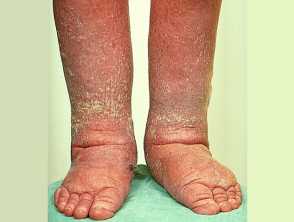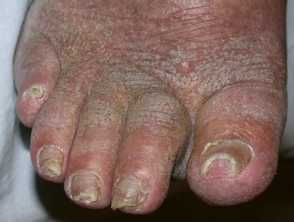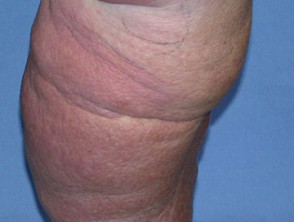What is lymphoedema?
Lymphoedema (American spelling ‘lymphedema’) is a swelling of part or parts of the body that occurs when the lymphatic system is not working properly. Lymphoedema can be localised to a small area, or diffuse over a large area such as one or both upper or lower limbs.
To understand how lymphoedema occurs we need to know a bit about what the lymphatic system is and how it works.
What is the lymphatic system?
The lymphatic system forms part of the immune system and part of the vascular system.
The lymphatic system is made up of many tiny vessels that run throughout the body and gradually join together to form bigger vessels. In the skin, small lymphatic vessels are found in the dermis but not in subcutaneous tissue. Running through these vessels is a clear fluid called lymph. Lymph contains the excess protein, water, bacteria and waste products that the body doesn’t require and travels along the lymphatic system until it reaches the lymph nodes (glands).
The lymph nodes, which are situated in the neck, armpits, groins and deep inside the chest and abdomen, filter and cleanse the lymph to remove any foreign matter (e.g. bacteria) and start any necessary immune reactions. Once passed through the lymph nodes, lymph finally drains into large veins located in the lower neck. Movement of adjacent muscles helps to keep the lymph moving along the lymphatic system. In addition the walls of the lymphatic vessels contract and valves inside the vessels keep things pumping.
Who gets lymphoedema?
Lymphoedema:
- Is more common in females than males
- Occurs in all races
- Can occur in babies and children, and may persist lifelong
- Can also begin in adult life
- Is commonly associated with obesity
Why does lymphoedema occur?
Oedema (swelling) occurs when excess fluid and protein from damaged blood vessels (e.g. after a burn or ankle sprain) enters into the lymphatic system at a rate too fast for the lymph to be carried away. This produces a temporary swelling which gradually resolves on its own as the damaged tissue heals, blood vessels no longer leak excessively and the lymphatic system can keep pace with the normal flow of lymph.
Lymphoedema is the name given to the swelling that occurs because of a damaged or blocked lymphatic system. Protein, water and waste products are released into tissue in the normal way but a damaged lymphatic system prevents the drainage away and swelling of the affected area results (lymphostasis). In addition, the limb may become inflamed.
Localised lymphoedema
Examples of localised or circumscribed lymphoedema include:
- Scar lymphoedema
- Solid facial/eyelid oedema in patients with phymatous rosacea
- Pendulous swelling and masses in morbidly obese patients
- Anogenital fibroepithelial polyps (large firm skin tags)
- Non-pitting genital swelling in Crohn disease
- Swelling around arthritic joints
Diffuse lymphoedema
There are basically two types of diffuse lymphoedema based on the underlying causes.
Primary lymphoedema
- Primary lymphoedema is also known as Milroy disease.
- Damaged lymphatic system is usually present at birth (usually as a result of underdevelopment)
- Affects both sexes, although 70–80% of cases are female
- Age of onset varies – swelling is present at birth in 10% of cases, 80% develop swelling before 35 years and 10% after 35 years
- Commonest sites for swelling are the legs, arms, genitals and face
Secondary lymphoedema
- Impaired functioning of the lymphatic system is caused by some other condition or factor
- Chronic venous insufficiency – due to incompetent superficial and/or deep veins in the lower legs resulting in venous hypertension (increased pressure) and secondary damage to the lymphatic system
- Surgery – removal of lymph nodes when treating some cancers, eg, breast, prostate
- Radiotherapy – used to treat cancer but can cause scar tissue that interrupts lymphatic flow
- Accidental trauma, injury or infection (eg cellulitis) that directly damages lymph vessels
- Reduced mobility – movement keeps the muscle contracting which helps the flow of lymph
- Lymphatic filariasis
What are the clinical features of lymphoedema?
Initially the symptoms and signs of lymphoedema may be very slight and almost unnoticeable. If left untreated, the swelling may get bigger and eventually become permanent. Some or all of the following symptoms may be experienced in diffuse lymphoedema.
- Feeling of tightness and heaviness in a limb
- Altered sensation, such as pins and needles, shooting pains or feeling of heat
- Joint discomfort due to the swelling, eg elbow, knee
- Tenderness in the groin of an affected leg
- Changes in temperature of the limb or affected skin
- Reduced range of movement
At first the swollen area will pit if pressed with a thumb. However, as it becomes bigger and harder it will no longer pit. If lymphoedema is left untreated and the swelling gets worse, skin changes may occur. The skin may get very thick with folds and bulges and cannot be lifted up or pinched. Dry warty spots appear on the ankles, feet and toes (elephantiasis nostras verruciformis, or lymphatic papillomatosis).
Lymphoedema of the legs is often worse than that of the arms as lymphatic drainage from the legs is more difficult. Walking becomes difficult as the patient carries the excess weight.
Complications of lymphoedema
What are the complication of lymphoedema?
Complications are common in severe diffuse lymphoedema.
- Because immune cells fail to circulated through the affected tissue, lymphoedema results in localised immune deficiency making it prone to bacterial infection (impetigo and cellulitis). This is particularly the case if lymph leaks on to the skin surface or there are fissures in the skin.
- Lymphoedema results in breakdown of barrier function of the skin, leading to dermatitis.
- Development of contact allergic dermatitis is delayed due to immune deficiency, but if it develops can be severe and difficult to treat effectively.
- Severe lymphoedema is associated with chronic inflammation and fibrosis (scarring).
- Lymphoedema may be complicated by skin cancers including angiosarcoma (Stewart Treves syndrome), basal cell carcinoma, squamous cell carcinoma, and sebaceous carcinoma. Tumours are often multiple.
- Viral warts are more prevalent in lymphoedematous skin than unaffected skin.
- The warty papillomas and polyps arising in elephantiasis nostras verruciformis) may be due to activation of human papillomavirus (betaHPV).
How is the diagnosis of lymphoedema made?
Diagnosis of lymphoedema is made from a patient's history and observation. The possibility of cancer should be investigated if a cause cannot be found for swelling. In some difficult cases a radiographic test called lymphoscintigraphy may be performed. This measures lymphatic function and gives a fair image of the lymphatic system.
Lymphoedema should be distinguished from lipoedema, in which swelling of both thighs and lower legs is due to the accumulation of fat under the skin.
What is the treatment for lymphoedema?
Lymphoedema is an ongoing condition that has no known cure. The main goal of treatment is to reduce the swelling and keep it to a minimum. It is very important to treat lymphoedema in its early stages to prevent further swelling and complications such as infection. If a cause is found then the cause needs to be treated, e.g. cancer.
For patients with mild to moderate swelling of their limbs a treatment regimen called Complex Physical (Lymphatic/Lymphoedema) Therapy (C.P.T./C.L.T.) is recommended. This regimen consists of 4 main parts.
- Skin care – this involves keeping the skin clean to reduce infection, the use of emollients to restore and maintain skin suppleness, and keratolytics to remove hard, dead skin.
- Simple lymphatic drainage – this is a gentle massage technique that uses simple hand movements to try to move the swelling out of the affected area. The patient, relative or caregiver is taught the technique.
- Compression bandaging, sleeve or stocking to help prevent swelling from building up in the limb again.
- Exercise and movement – specially designed programme to supplement the massage and help by maximising lymph drainage without over exertion
For people with more severe swelling, additional treatments are usually recommended. These include:
- Manual Lymphatic Drainage – specialised form of massage carried out by a trained therapist to move the skin in specific directions based on the underlying anatomy and physiology of the lymphatic system.
- Multi-Layer Lymphoedema Bandaging – multi-layer system of compression bandages
- Drug therapy – research is ongoing as to the effectiveness of drug therapy in lymphoedema. Benzopyrenes including flavonoids have been used. Coumarin use has been discontinued due to hepatic toxicity.
- Surgery – rarely performed but may be of benefit for eyelid or genital swelling. Only surgeons who have experience with lymphoedema and the lymphatic system should perform surgery.


